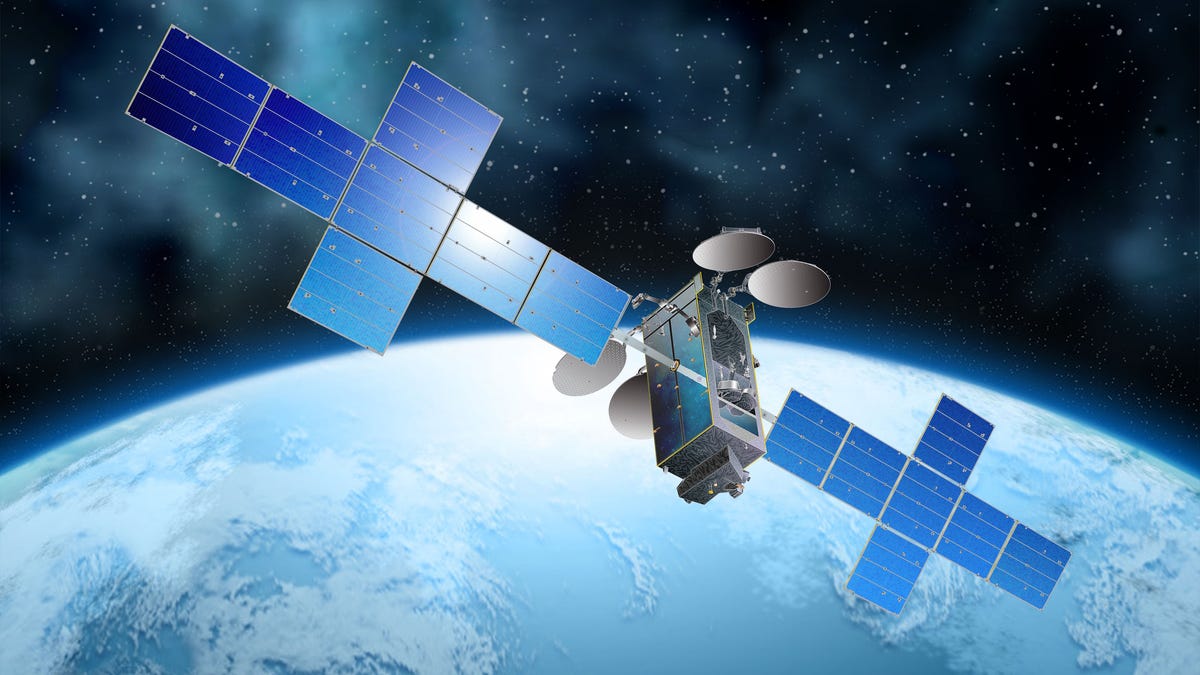After a two-day delay, a SpaceX on Friday night launched Hughes Network Systems’ Jupiter 3, a satellite designed to modernize an old-school approach to space-based internet access. A Falcon Heavy rocket carried the satellite to an altitude of nearly 18,000 miles above the Earth’s surface before releasing it into orbit three and a half hours after launch.
The satellite activated its solar panels, communicated with controllers on Earth, and is in good health, manufacturer Maxar Technologies said in a statement Saturday. Jupiter 3, also called EchoStar XXIV, is the largest commercial communications satellite ever built, Maxar said.
When it goes into service in the fourth quarter of 2023, Jupiter 3 should quadruple Hughes’ download speeds to 100 megabits per second, making the technology more useful in a data-hungry world. Hughes hasn’t yet revealed prices for the faster new service.
Launching a single massive communications satellite contrasts sharply with much of the satellite broadband innovation today from SpaceX’s Starlink and rivals like OneWeb and Amazon’s Kuiper. They employ “constellations” of hundreds of smaller, cheaper satellites orbiting relatively close in low Earth orbit.
Hughes’ Jupiter 3 satellite is the size of a school bus, and when its solar panels unfold it will be 127 feet across, about the height of a 10-story building.
Hughes’ Jupiter 3 couldn’t be more different. It’s a single nine-ton satellite the size of a bus — 27 feet long and 127 feet wide once its solar panels are deployed. It’s designed to circle the Earth in sync with the planet’s rotation in a much higher geostationary orbit 22,236 miles above the equator. That choice parking place is fixed in the sky, meaning antennas can be pointed at it without having to reconnect with a constant parade of low Earth orbit satellites whizzing by closer to the planet.
Most of us are better served by cable or fiber-optic broadband that offers higher speeds and shorter communication delays, called latency. But for rural customers and others who are beyond the reach of more conventional network technology, satellite communications can play a key role connecting people who are hard to bring online.
“These folks that haven’t experienced these types of service levels ever before,” said Mark Wymer, Hughes’ senior vice president of business development and strategy.
People living off the beaten track often rely on satellite-based communication services. This house in the village of Kasaan, Alaska, has a satellite dish antenna in its front yard.
Space has become more accessible to startups and established companies with SpaceX driving launch costs down. But it still poses formidable engineering challenges. In July, Hughes competitor Viasat disclosed a disastrous malfunction with its ViaSat-3 satellite, a problem deploying the satellite’s unusually large reflector that beams radio waves to ground stations.
Hughes’ launch, from Cape Canaveral in Florida, uses the same rocket as ViaSat-3, SpaceX’s Falcon Heavy. It can propel up to 64 metric tons of payload to low Earth orbit and 27 metric tons to geostationary transfer orbit, the precursor orbit satellites use before being nudged into geostationary orbit.
Jupiter 3 has a total communication capacity of 500 gigabits per second. That includes communication to and from the terminals that customers have and with the Hughes ground stations that link the satellite to the broader internet.
“We’ve colocated those in data centers where a lot of major content players house their data to eliminate delays and latency,” Wymer said.
The new low Earth orbit constellations of broadband satellites are “forcing us to innovate,” he said. One example is Hughes’ Fusion service, which combines communications with OneWeb’s low Earth orbit satellites either with 4G mobile phone network technology or with Hughes’ Jupiter geosynchronous satellites. (Hughes, a division of EchoStar, is a major OneWeb investor.)
Instant broadband during disasters or war
Satellite broadband also can play an important role in areas disrupted by war or natural disasters. SpaceX’s Starlink terminals have been important for Ukrainian forces fighting the Russian invasion, and satellite links could be important if attacks disrupt the massive network of subsea internet cables crucial to international commerce and communications.
Hughes’ Jupiter 3 satellite, packaged in a large white container, is loaded onto a bulging Antonov cargo jet in Silicon Valley for shipment to Florida for its launch.
Hughes works with the US Federal Emergency Management Agency, or FEMA, to help emergency crews set up temporary cellphone networks after disasters. “We can go in within a moment’s notice and establish or reestablish those communication lines,” Wymer said.
Along with individual customers, Hughes’ Jupiter satellites also supply “backhaul” connections to remote cell towers that lack terrestrial connections and to communities, particularly in South America, that set up community internet access points.
Maxar Technologies designed and built Jupiter 3 at its offices in Palo Alto, California. Hughes shipped the spacecraft to Cape Canaveral using an enormous Ukrainian Antonov aircraft.

